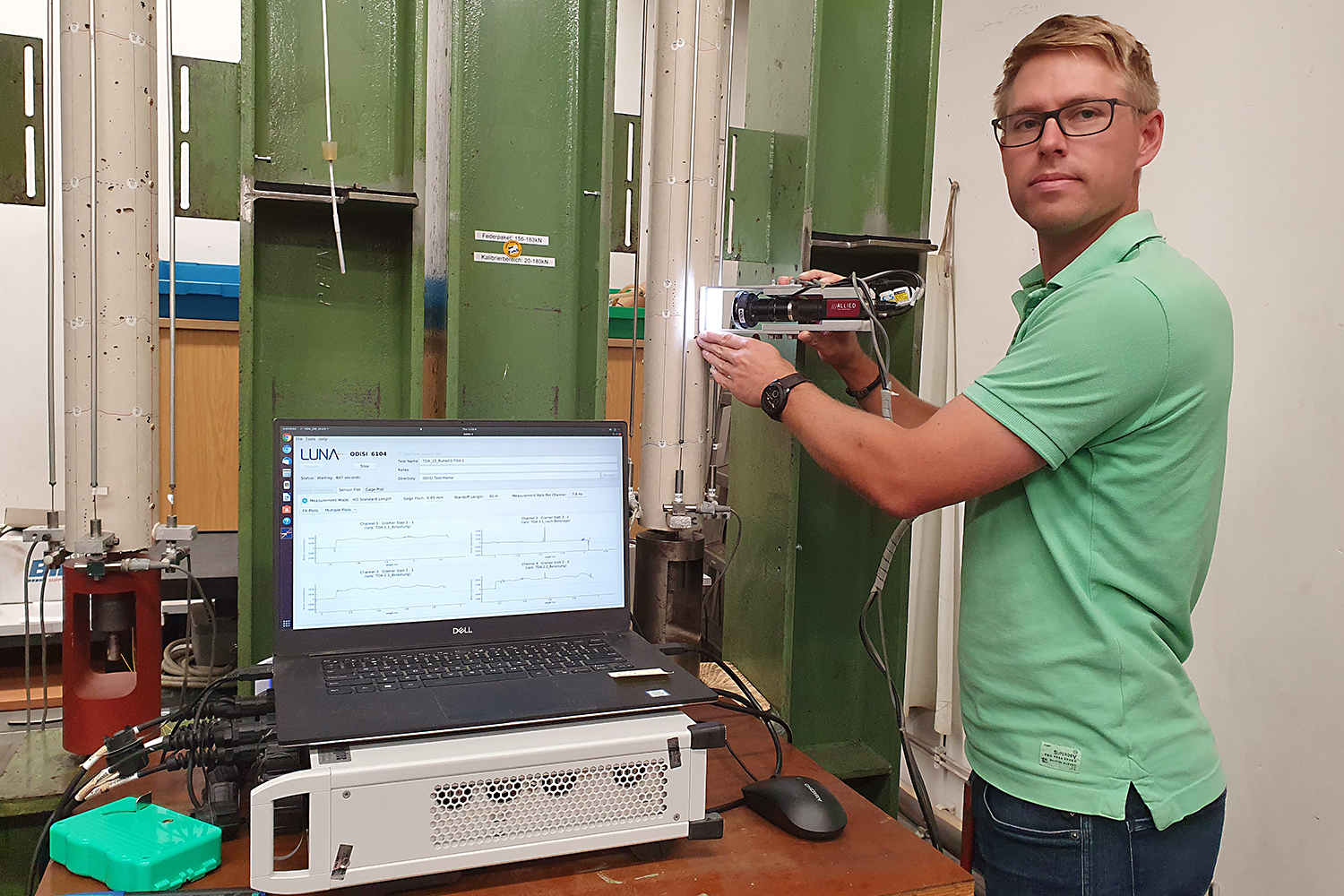When the crack in the reinforced concrete becomes too wide A short portrait of Jonas Cramer from the Research Training Group 2075
How do cracks in structures develop and change? Jonas Cramer is doing research on this topic in the Research Training Group 2075 “Modelling the constitutional evolution of building materials and structures with respect to aging” in the Core Research Area “Future City”. The correct name of his research project is ” Local investigations of crack width development under service loads”. We introduce the doctoral student and research associate at the Institute for Building Materials, Concrete Construction and Fire Safety with a short portrait.

Jonas Cramer measuring crack widths with a digital crack width camera. Picture credits: Institute for Building Materials, Concrete Construction and Fire Safety/TU Braunschweig
Who are you and what is your research topic?
My name is Jonas Cramer and I studied civil engineering at TU Braunschweig. In my master’s thesis, I focused on cracks in reinforced concrete components – such as those that can occur in bridges – and their behavior over time. The topic may sound very boring at first, but I was fascinated by this topic and the related research. In the end, I started working as a research assistant at the Institute for Building Materials, Concrete Construction and Fire Safety (iBMB), Division of Concrete Construction. Subsequently, I applied for the Research Training Group 2075, because the diversity convinced me and my previous research fit perfectly into the context, but more about this later…
Which research question are you working on?
Before I start throwing around terms like “serviceability” or “macro-level”, I’ll try to keep it simple. In summary, I am looking at the formation of cracks taking into account long-term effects in reinforced concrete components, i.e. how these cracks develop and change over the lifetime of a structure. First of all, it is important to know that cracks in reinforced concrete structures are quite normal. Yes, even necessary for the inserted reinforcing steel to be effective at all. The trick, however, is to limit the crack width to a value below 0.2 to 0.4 millimeters so that no damage results from this. As already mentioned, in reinforced concrete construction a narrow crack is usually not a damage!
Cracks are also always associated with aging of the structure. Here, one can perhaps bring human wrinkling into play. Once the wrinkles are there, they generally do not go away on their own. Similar to humans, however, a crack can also be injected with a substance should the wrinkles – er, the cracks – become too large.
What inspires you about your research?
People who ask me about my research topic have often regretted this, since this question usually leads to a long monologue on my part. Interruptions unwanted!
The enthusiasm is definitely there, but I can’t say exactly what it is. Basically, I like the variety at the institute, where the one or other experiment also contributes. After all, what could be better than being paid for breaking something? Okay, the preparation of the experiments and the evaluation of the data are of course not to be neglected. In addition, there is the sense of achievement when the experiment can be correctly recalculated with a specially created calculation model (we refer to this as “validation”). Before this, however, one or two failures must be overcome (we call this “calibration”).
Why is your topic relevant to the Future City?
In the future, too, we will hardly be able to do without buildings or structures, and concrete or reinforced concrete will be used at the latest for the foundation. From my point of view, it is of great importance to design buildings with a long lifespan and thus to build them in a resource-saving and sustainable way. Against this background, it is important to further develop construction methods and to keep the focus on durability as well as to be able to make predictions on aging. After all, as already noted, not every crack is a damage. What must never be neglected, of course, is the stability of a structure. So we have to be sure that aging – be it in reinforced concrete construction, in steel construction, in timber construction or elsewhere – does not lead to a structural safety problem.
What is special about participating in the Research Training Group “Modelling the constitutive evolution of building materials and structures with respect to aging”?
What’s special about the Research Training Group is certainly that you have to deal with many different disciplines here, so that in addition to former fellow students, you sometimes also run into doctoral students from mechanical engineering. This opens up completely new perspectives, through which you constantly develop yourself and also learn to discuss and advance scientific topics with people who are supposedly from other disciplines (and ultimately we all are, as long as it’s not about our own research topic). So it is not only about dealing with your own topic, but you are also in the middle of other research topics and help each other.
